- Research Services
- Capabilities
- About Us
- Resources
- Contact Us
 Pulmonary Fibrosis
Pulmonary Fibrosis Allergic Asthma
Allergic Asthma Acute Lung Injury, ARDS, and COPD
Acute Lung Injury, ARDS, and COPD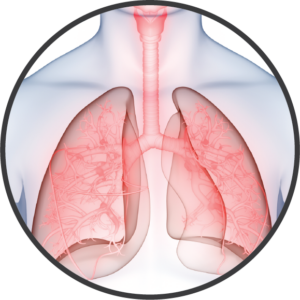 Pulmonary Disease
Pulmonary DiseaseBioModels has extensive experience with a variety of animal models that capture critical mechanisms of pulmonary disease. Work with our team to:
Assess your experimental materials for efficacy and mechanism of action in BioModels’ established pulmonary fibrosis models. Pulmonary fibrosis is a chronic/progressive lung disease that presents with difficulty breathing due to thickened and scarred lung tissue. BioModels’ pulmonary fibrosis models capture a spectrum of disease mechanisms, allowing you to select the model most relevant for your hypothesis. The BioModels team is experienced with numerous preclinical pulmonary models, including bleomycin- and radiation-induced in vivo models and an in vitro model of fibrosis.
Experimental endpoints for these models include:
Assess your experimental materials for efficacy and mechanism of action in BioModels’ established allergic asthma models. Asthma is a condition in which inflammation of the airways results in difficulty breathing, shortness of breath and wheezing. BioModels’ asthma models capture a spectrum of disease mechanisms, allowing you to select the model most relevant for your hypothesis. The BioModels team is experienced with numerous preclinical rodent allergic asthma models, including acute and chronic models that utilize various common allergens, and diverse experimental endpoints, such as:
Assess your experimental materials for efficacy and mechanism of action in BioModels’ established acute lung injury models. Acute lung injury (ALI), acute respiratory distress syndrome (ARDS), and chronic obstructive pulmonary disease (COPD) are diseases characterized by neutrophilic inflammation of the lung and marked decreases in lung compliance in ALI or ARDS. In COPD however, there is increased lung compliance associated with progressive lung destruction. BioModels’ ALI models capture a spectrum of disease mechanisms, allowing you to select the model most relevant for your hypothesis. The BioModels team is experienced with numerous preclinical ALI models, including lipopolysaccharide (LPS) – and hydrochloric acid (HCl) -induced in vivo models.
Experimental endpoints for these models include:
Study Models

The intratracheal (IT) bleomycin-induced pulmonary fibrosis model is the standard model of human lung fibrosis. After being anesthetized, animals have a cannula inserted into the trachea and down into the lungs and then bleomycin is slowly infused into the lungs. Animals are evaluated daily for body weight and respiratory status. After animals are sacrificed, lung weight, collagen content and fibrosis scores are determined.
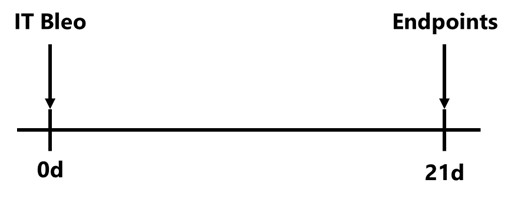
C57Bl/6 mice are administered Bleomycin once on Day 0 by intratracheal route. Endpoints are assessed on Day 21.
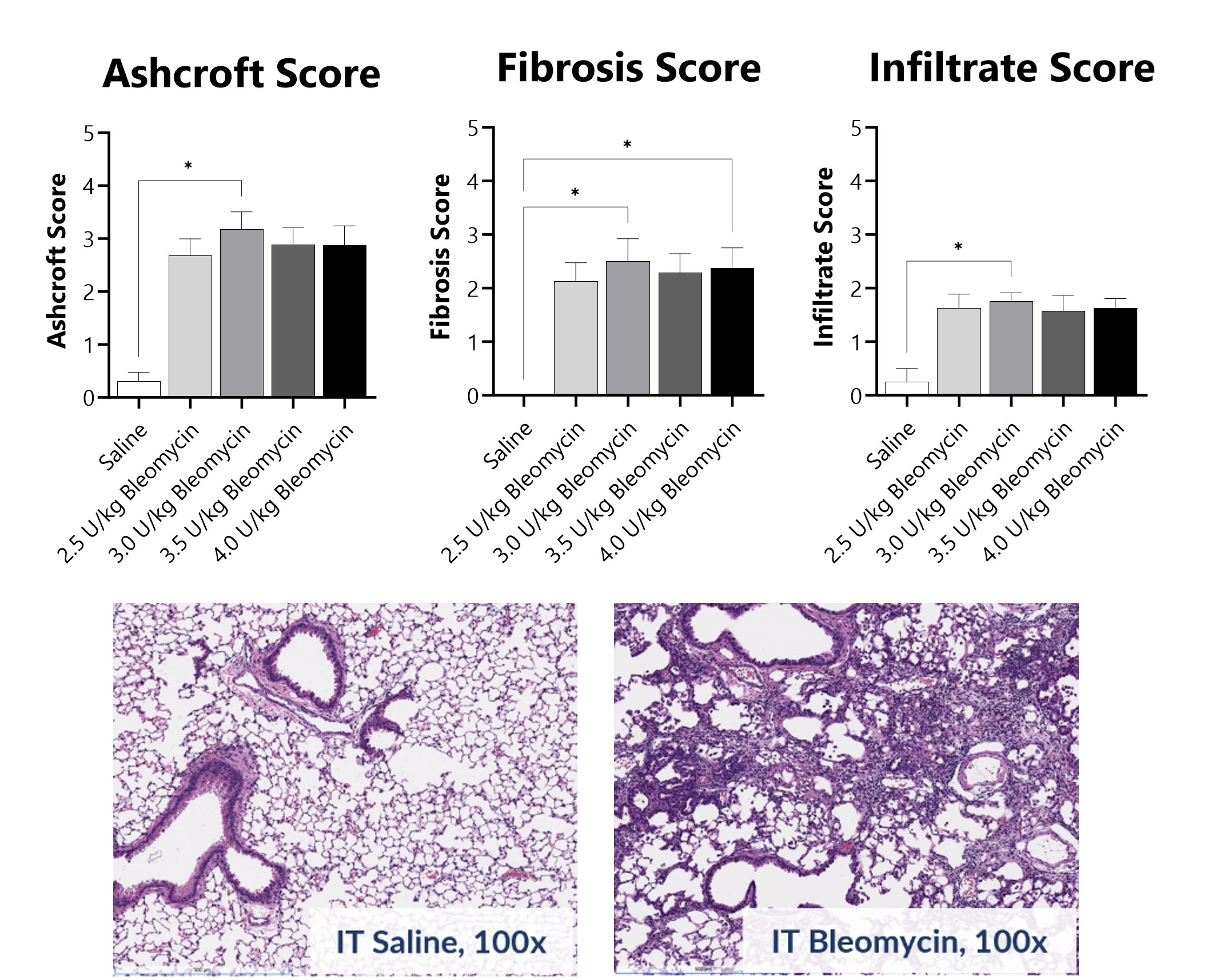
Pathology assessment of Day 21 lungs from IT-Bleomycin administered animals. Ashcroft score was determined in H&E-stained tissue using a modified Ashcroft Scale graded from 0-8. Fibrosis score was determined in Masson’s Trichrome-stained tissue using a 0-5 semi-quantitative scoring scale of area staining positive for collagen. Infiltrate score was determined in H&E-stained tissue using a 0-5 semi-quantitative scoring scale based on severity of mononuclear cell infiltration. Images are from animals receiving saline or 3.0 U/kg Bleomycin. Histopathology, immunohistochemistry, and analysis were performed by Dallas Tissue Research. (*p<0.05 compared to the saline-control)

Alpha smooth muscle actin (αSMA) and Collagen I + III Immunohistochemistry in Day 21 lungs from IT-Bleomycin administered animals. Whole slide images were used for global and regional αSMA quantification using a deep learning algorithm. Images are from animals administered either saline or 3.0 U/kg Bleomycin. Histopathology, immunohistochemistry, and analysis were performed by Dallas Tissue Research.

Wet lung weight and wet lung weight normalized to Day 21 body weight of Day 21 lungs from IT-Bleomycin administered animals.
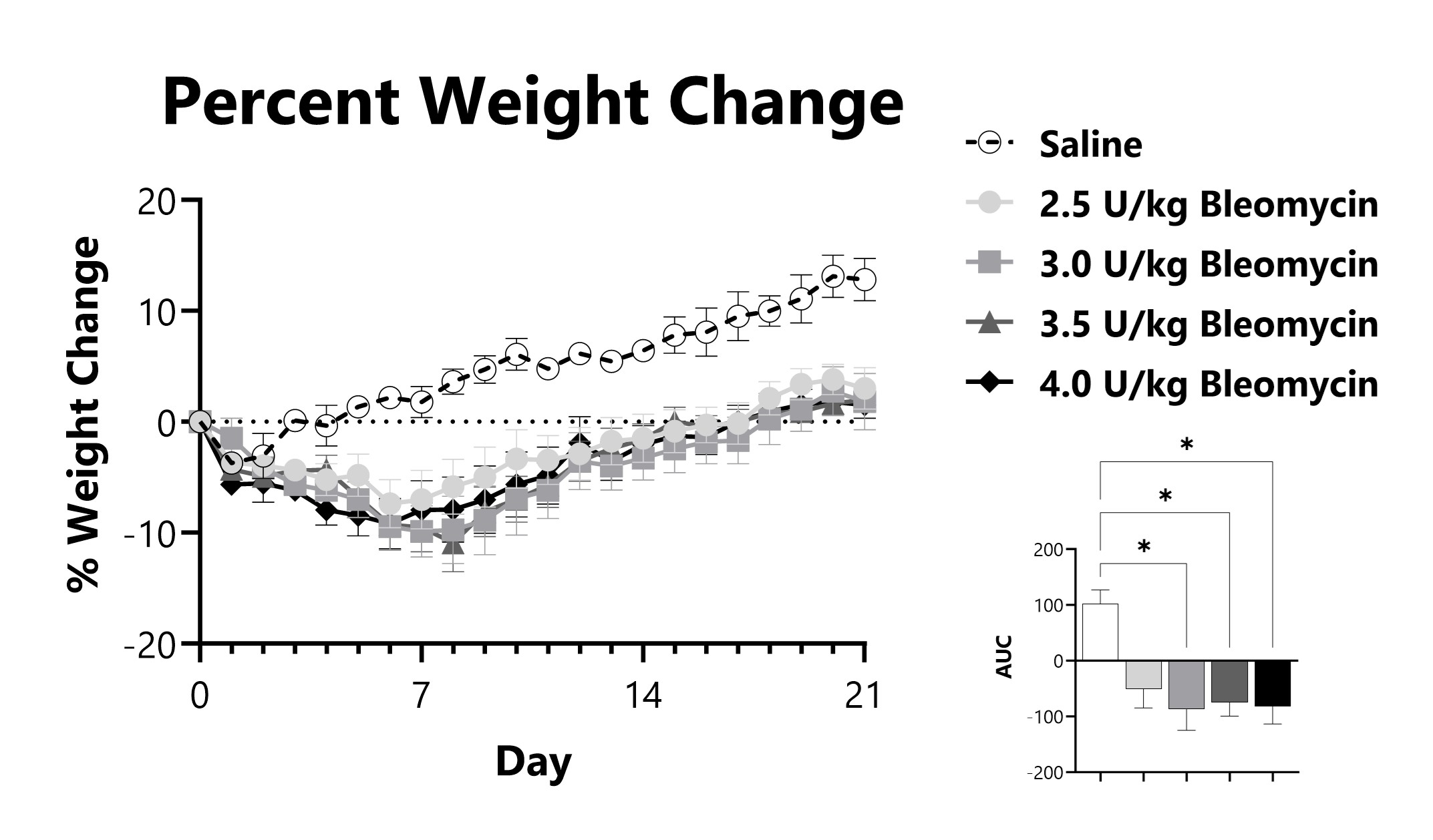
IT-Bleomycin administered animals are weighed daily, and body weight compared to Day 0 is calculated. The AUC is calculated to compare treatment arms and is shown in the inset. (*p<0.05 compared to the saline-control)
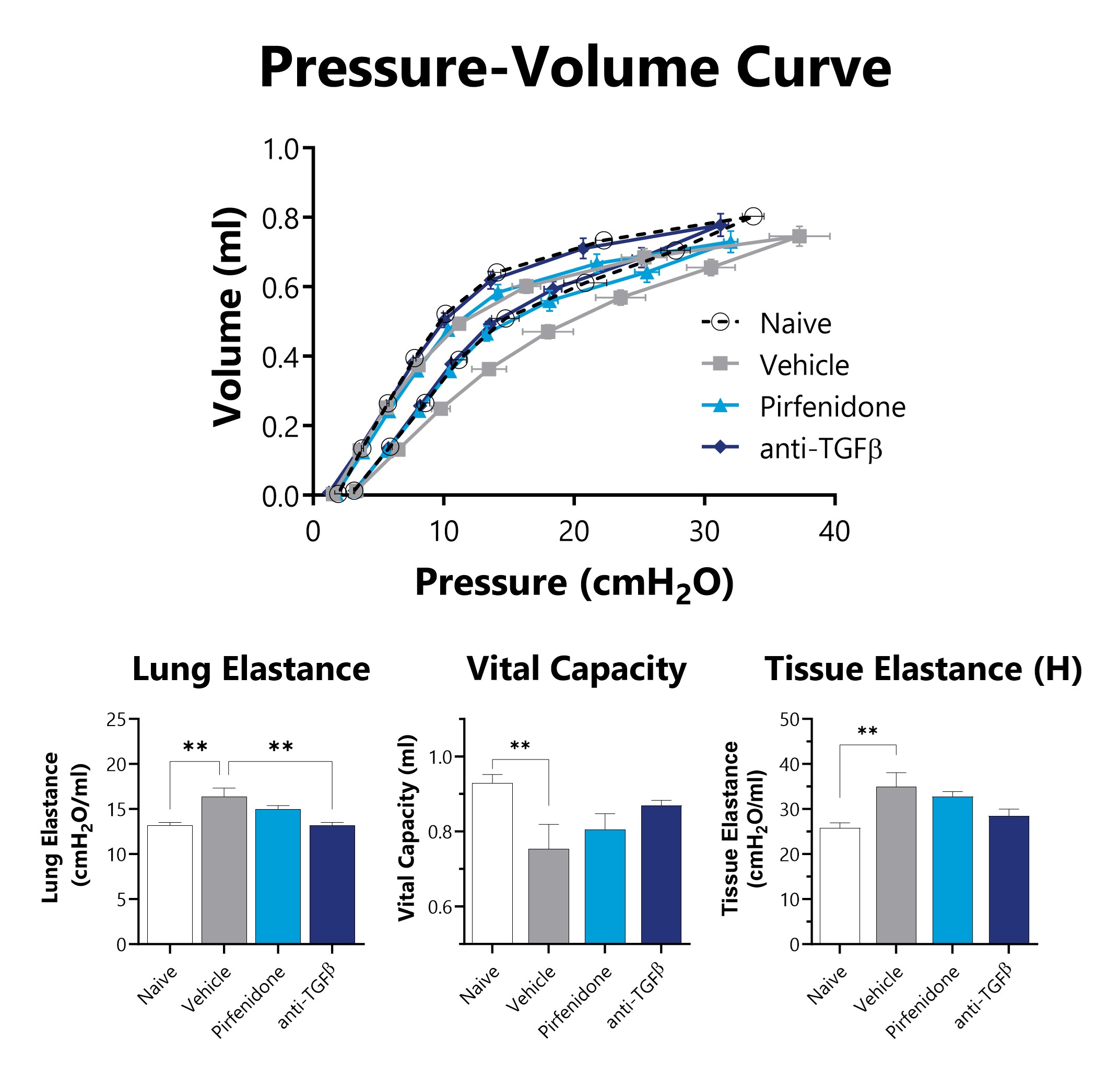
IT-Bleomycin administered animals have lung mechanics measured on Day 21 using a flexiVent mechanical ventilator. Improved lung function is observed in mice administered intratracheal bleomycin when treated with either pirfenidone or anti-TGFβ neutralizing antibody. (**p<0.01 compared to the naïve group)
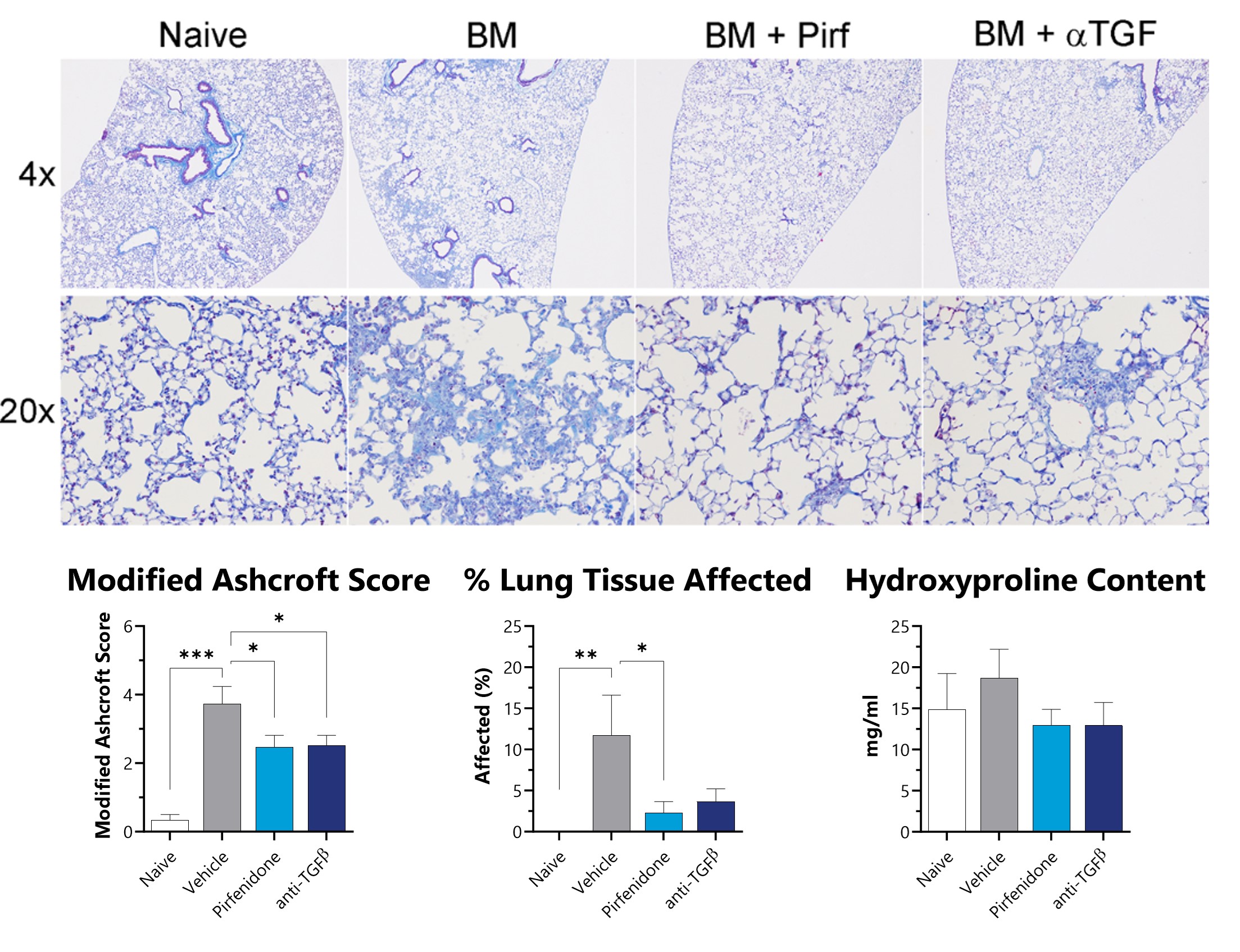
Lungs from IT-Bleomycin administered animals were collected on Day 21, processed for histopathology, and a modified Ashcroft score was assigned by a board-certified veterinary pathologist. Fixed tissue was also assessed for percent area of fibrotic lung tissue. Pulverized lung samples were assessed hydroxyproline. Lower levels of fibrosis are observed in mice administered intratracheal bleomycin when treated with either pirfenidone or anti-TGFβ neutralizing antibody. (*p<0.05; **p<0.01; ***p<0.001 compared to the naïve group)

Close

Pulmonary fibrosis is induced by subcutaneously (SC) administering bleomycin over the course of 28 days. To induce disease, an osmotic pump containing bleomycin is subcutaneously implanted in the backs of anesthetized mice. Animals are evaluated daily for body weight and respiratory status. Following planned euthanasia, lung weight, collagen content and fibrosis scores are determined.
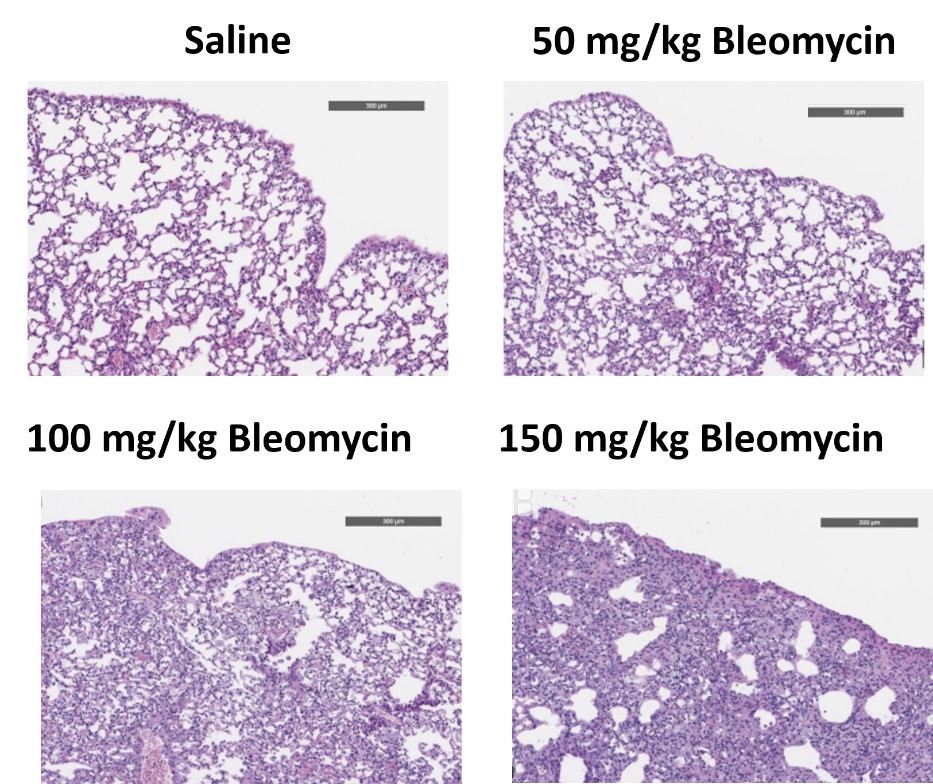
C57Bl/6 mice are administered Bleomycin for 28 days through a SC implanted osmotic pump and Day 28 lungs are processed for histopathology. H&E-stained lungs from animals administered saline or 50 mg/kg, 100 mg/kg, or 150 mg/kg Bleomycin.
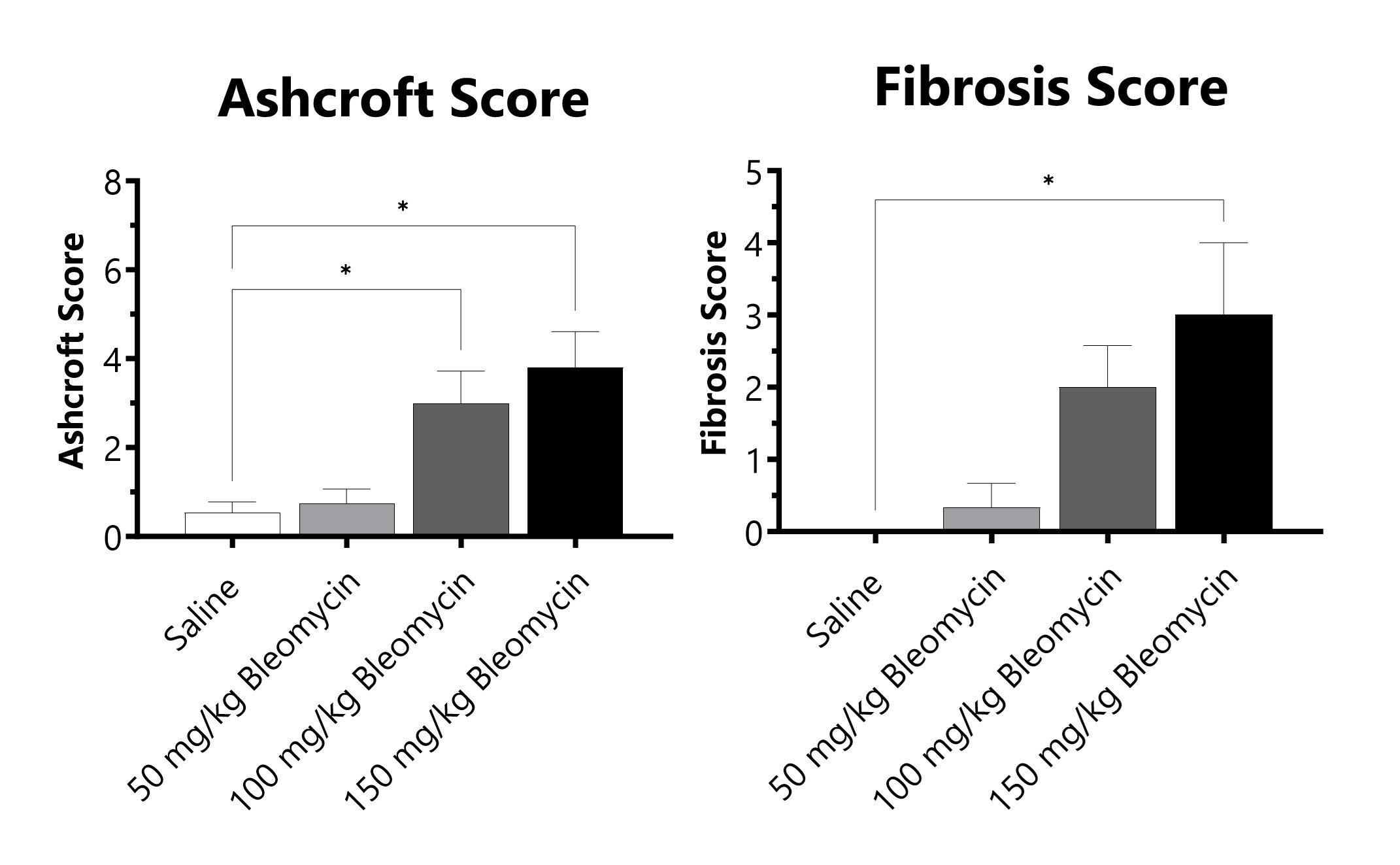
C57Bl/6 mice are administered Bleomycin for 28 days through a SC implanted osmotic pump. Pathology assessment of Day 28 lungs from SC Osmotic Pump-Bleomycin administered animals. Ashcroft score is determined in H&E-stained tissue using a modified Ashcroft Scale graded from 0-8. Fibrosis score is determined in Masson’s Trichrome-stained tissue using a 0-5 semi-quantitative scoring scale of area staining positive for collagen. (*p<0.05 compared to the saline-control).
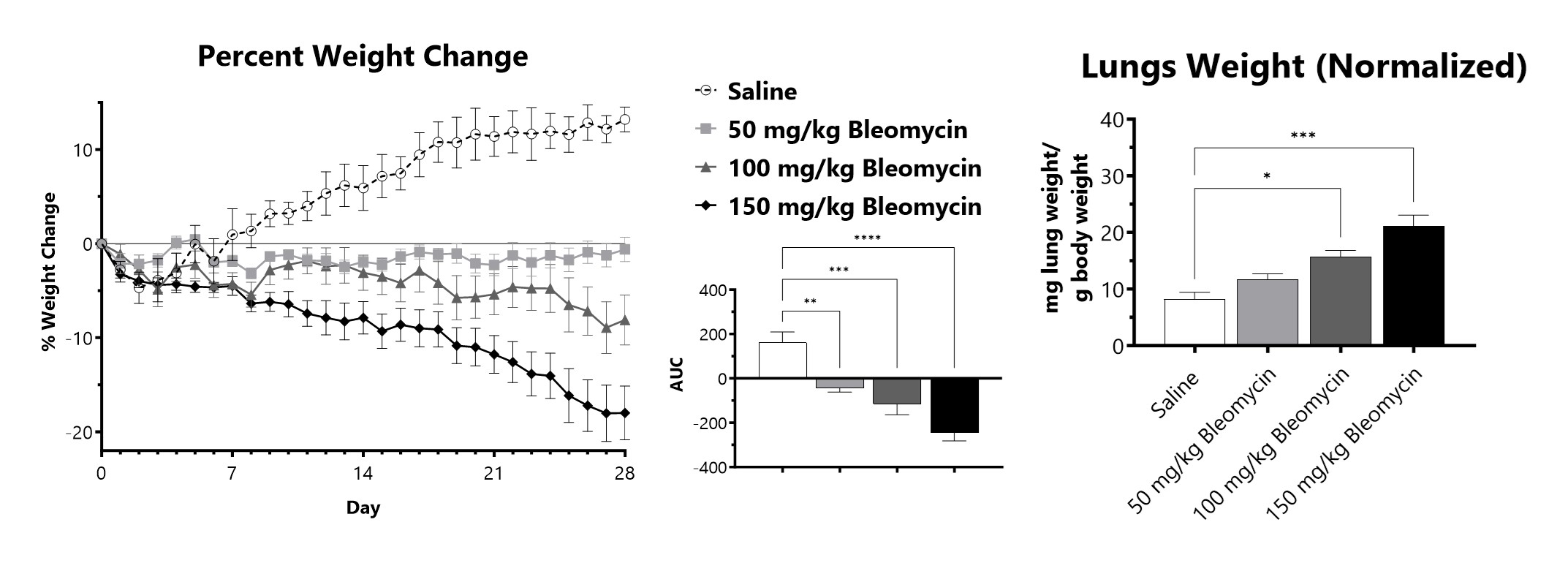
C57Bl/6 mice are administered Bleomycin for 28 days through a SC implanted osmotic pump. Animals are weighed daily, and body weight compared to Day 0 is calculated. The AUC is calculated to compare treatment arms and is shown in the inset. Wet lung weight normalized to Day 28 body weight of Day 28 lungs from SC Osmotic Pump-Bleomycin administered animals. (*p<0.05; ***p<0.001 compared to the saline-control).

C57Bl/6 mice are administered Bleomycin for 28 days through a SC implanted osmotic pump and BAL fluid is assessed at 28 days for total cells and total neutrophils following administration of either 50 mg/kg, 100 mg/kg, or 150 mg/kg Bleomycin. (*p<0.05; **p<0.01 compared to the saline-control).
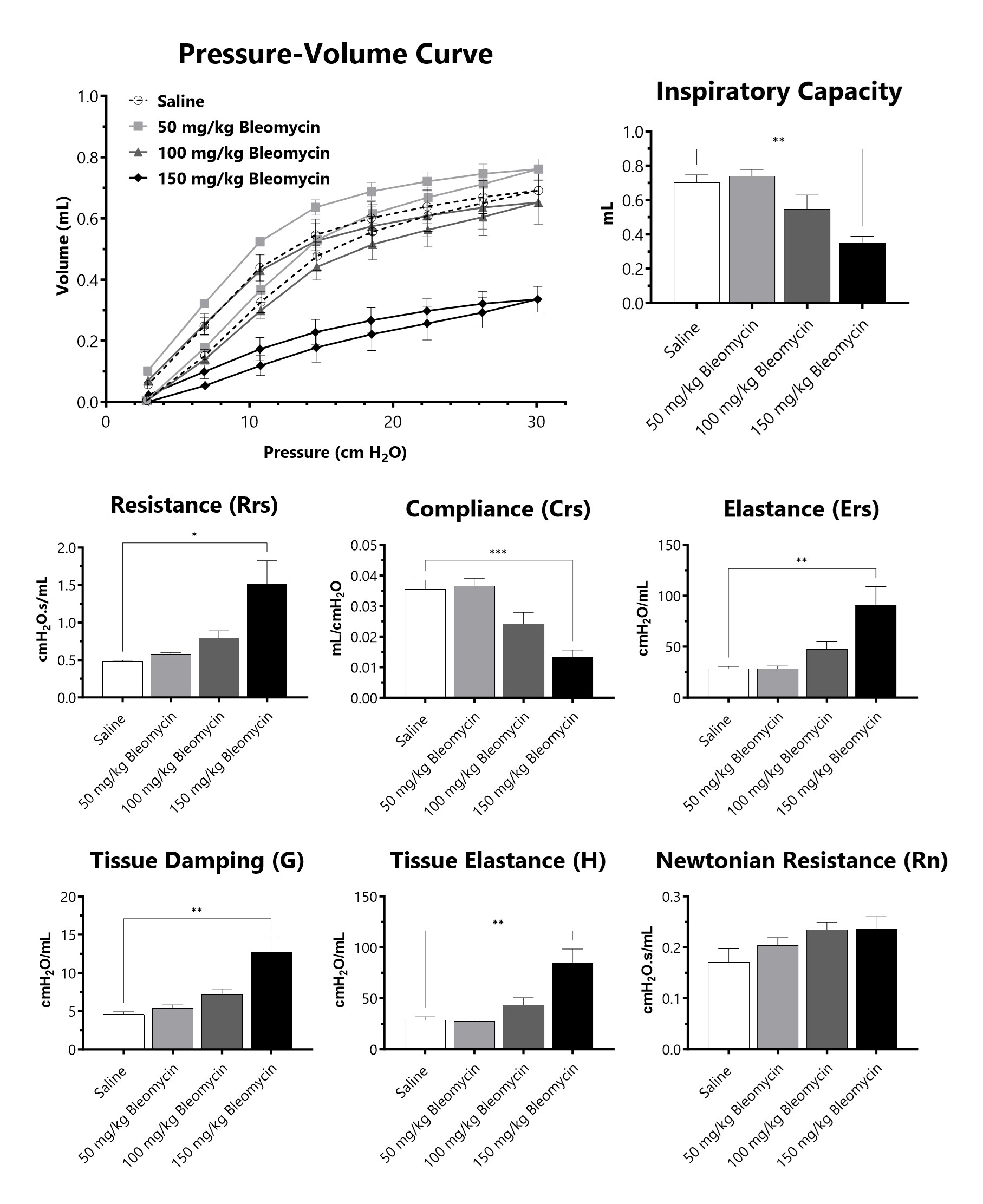
C57Bl/6 mice are administered Bleomycin for 28 days through a SC implanted osmotic pump and lung mechanics are assessed at 28 days following administration of either 50 mg/kg, 100 mg/kg, or 150 mg/kg Bleomycin. (*p<0.05; **p<0.01; ***p<0.001; ****p<0.0001 compared to the saline-control).

Close

Pulmonary fibrosis can be induced by targeting a dose of radiation specifically to the thorax of a mouse, developing disease over the course of 4-6 months. While fibrosis is slow to develop in this model, changes in lung function can be detected as early as 8 weeks post-irradiation. After being anesthetized, a single dose of radiation is targeted to the thorax, while the remainder of the body is protected with a lead shield. Animals are evaluated daily for body weight and respiratory status. After animals are sacrificed, lung weight, collagen content and fibrosis scores are determined.
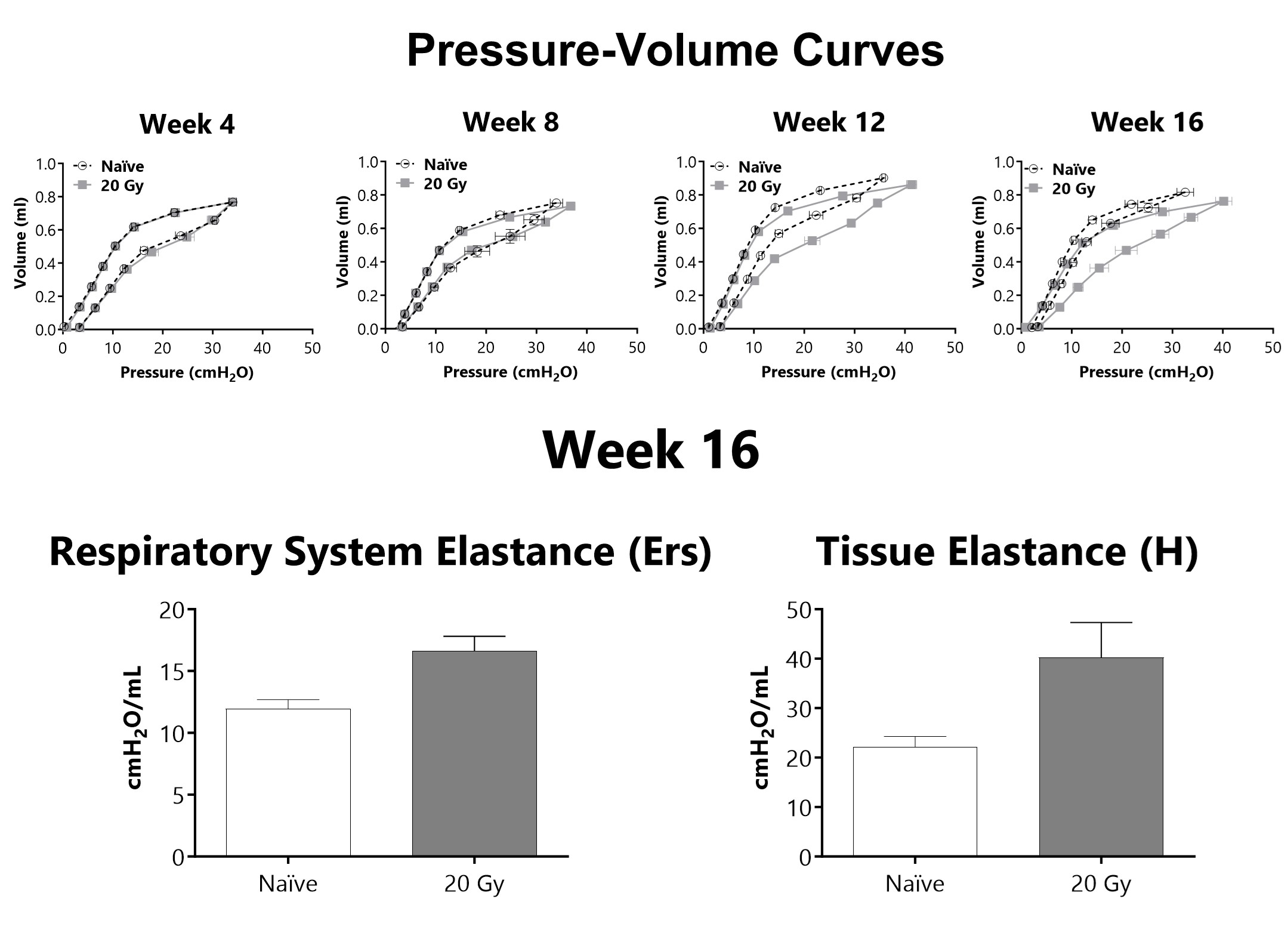
Lung mechanics are measured at either 4, 8, 12, or 16 weeks following administration of 20 Gy of radiation targeted to the thorax using a flexiVent mechanical ventilator. After 16 weeks, lung elastance (Ers) and tissue elastance (H) are increased in animals that received targeted radiation to the thorax.
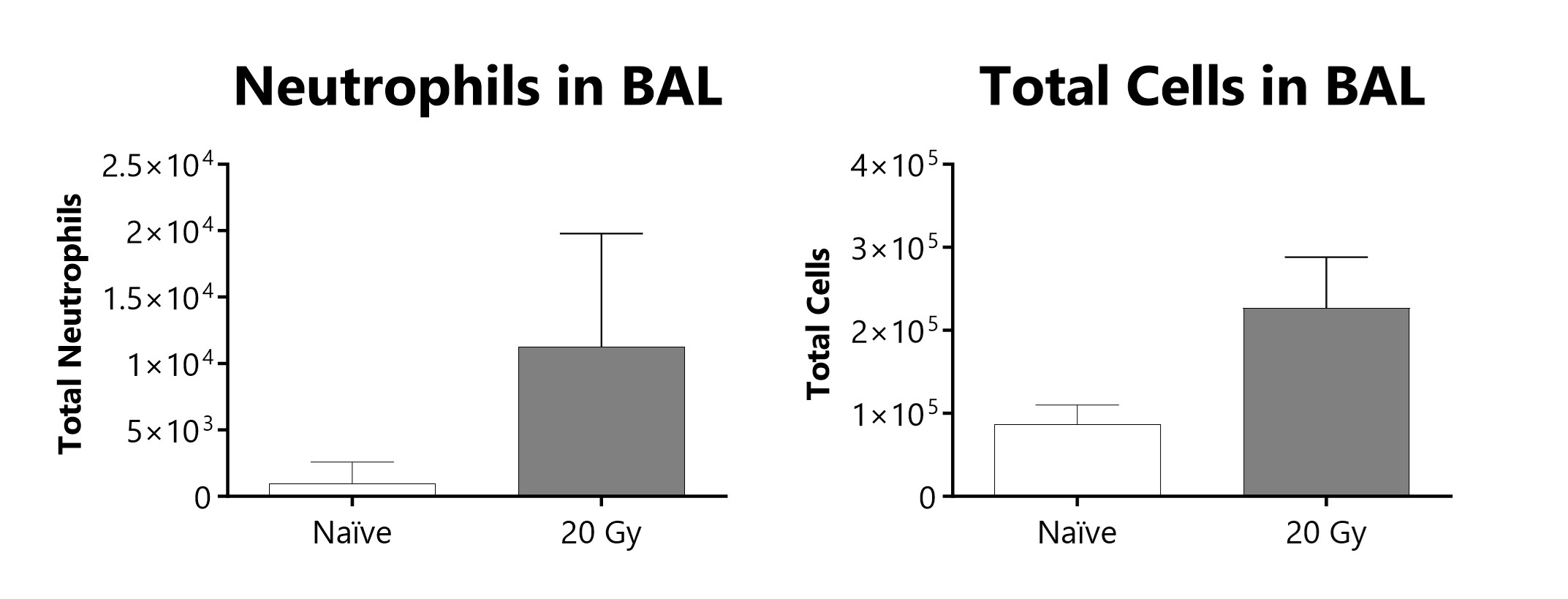
Total cells and neutrophils recovered in broncho-alveolar lavage fluid at week 16 of a radiation-induced pulmonary fibrosis model.
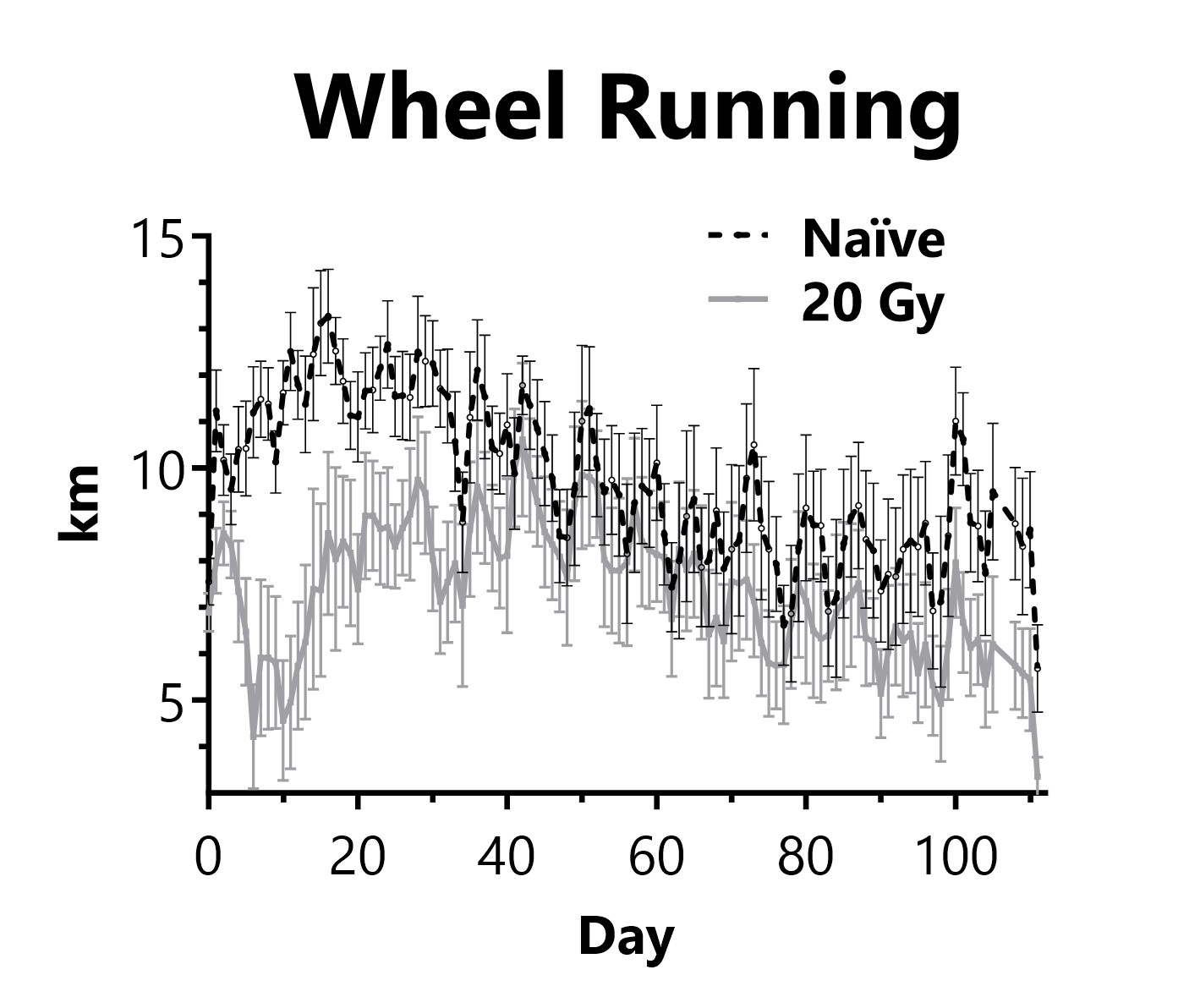
Animals are singly housed with a running wheel following administration of 20 Gy of radiation targeted to the thorax on Day 0. Daily distance traveled on the running wheel is recorded.

Close

At BioModels, we utilize a human in vitro model of TGF-β-induced fibrosis to screen potential therapeutics. TGFβ is added to confluent normal human lung fibroblasts (NHLF) for 48 hours. Supernatants and cell lysates are collected for endpoint analysis. Protein levels of Procollagen type 1-C peptide (PIP) and Plasminogen activator Inhibitor-1 (PAI-1) are determined to evaluate progression of fibrosis. Additionally, alpha smooth muscle actin (αSMA) is measured to indicate myofibroblast formation.

Confluent NHLFs are incubated for 48 hours with TGFβ. Levels of PIP and PAI-1 are assessed in cell culture supernatant and αSMA is measured in the cell lysate. (**p<0.01; ****p<0.0001 compared to the saline-control).

Close
Study Models

BioModels offers a mouse model of ovalbumin (OVA) induced allergic asthma. In the acute model, mice are sensitized with an intraperitoneal (IP) injection of OVA and adjuvant and then challenged with intranasal delivery of OVA followed by collections on day 16. Chronic versions of this model run from 4-12 weeks. The OVA model recapitulates many of the hallmarks of allergic asthma in humans, including elevated IgE and Th2 related cytokines, mucus hypersecretion, airway inflammation, goblet cell hyperplasia, epithelial hypertrophy, and airway hyperreactivity. Endpoints in this model include total and differential cell counts and inflammatory mediator content in the broncho-alveolar lavage fluid, airway hyperreactivity and detailed lung mechanics, as well as histopathology and immunohistochemistry.

BALB/c mice are sensitized with an IP injection of OVA with adjuvant on days 0 and 7. Mice are then challenged with OVA intranasally on days 13, 14, and 15 and endpoints are assessed on day 16. Reference treatment animals receive 3 mg/kg dexamethasone 1 hour prior to the challenges.
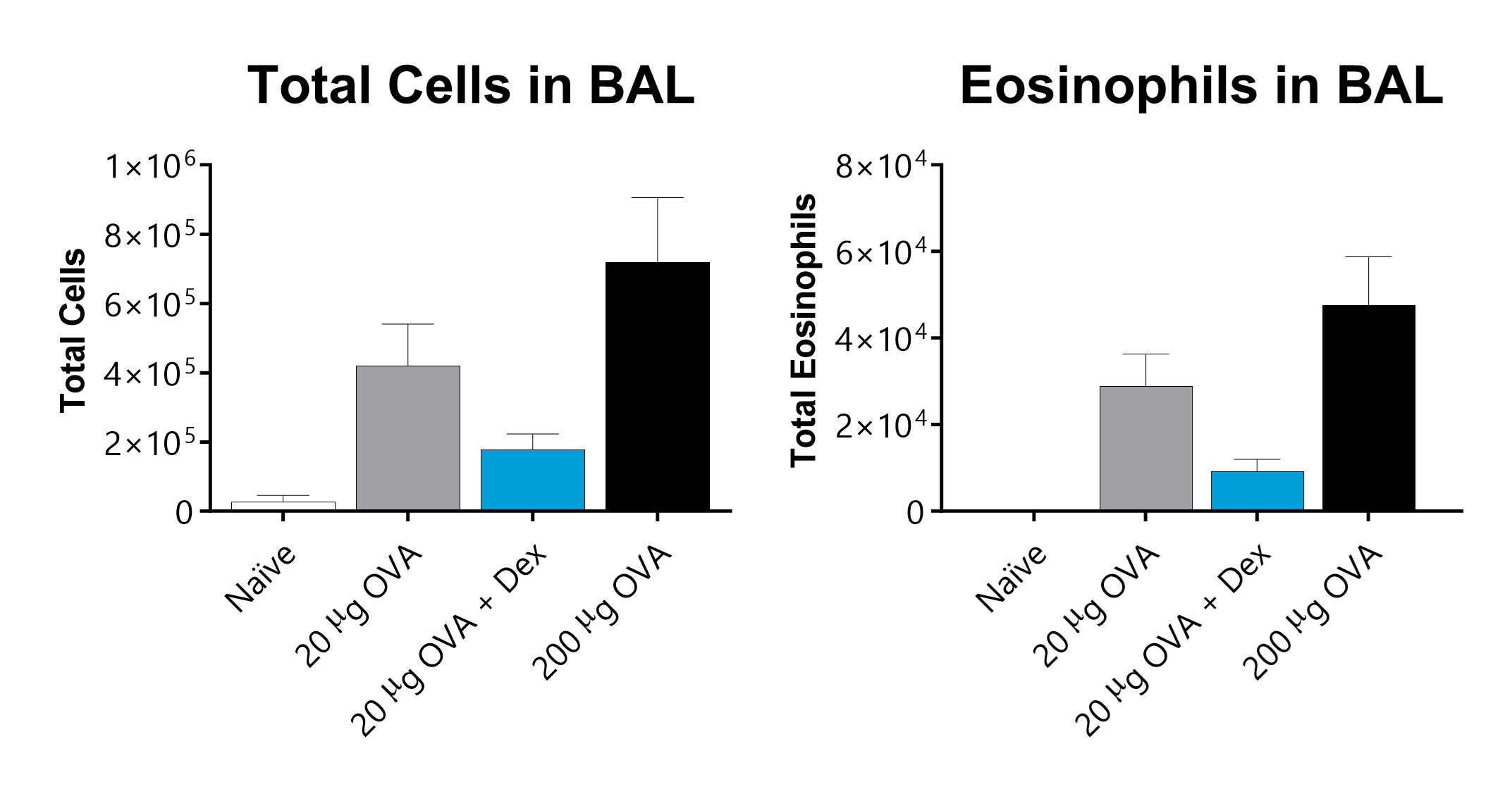
Total cells and eosinophils recover in broncho-alveolar lavage fluid on day 16 of an OVA-induced acute allergic asthma model. Mice demonstrate a dose responsive increase in total cells and eosinophils. Dexamethasone lower total inflammatory cell counts and eosinophils in the BAL fluid.
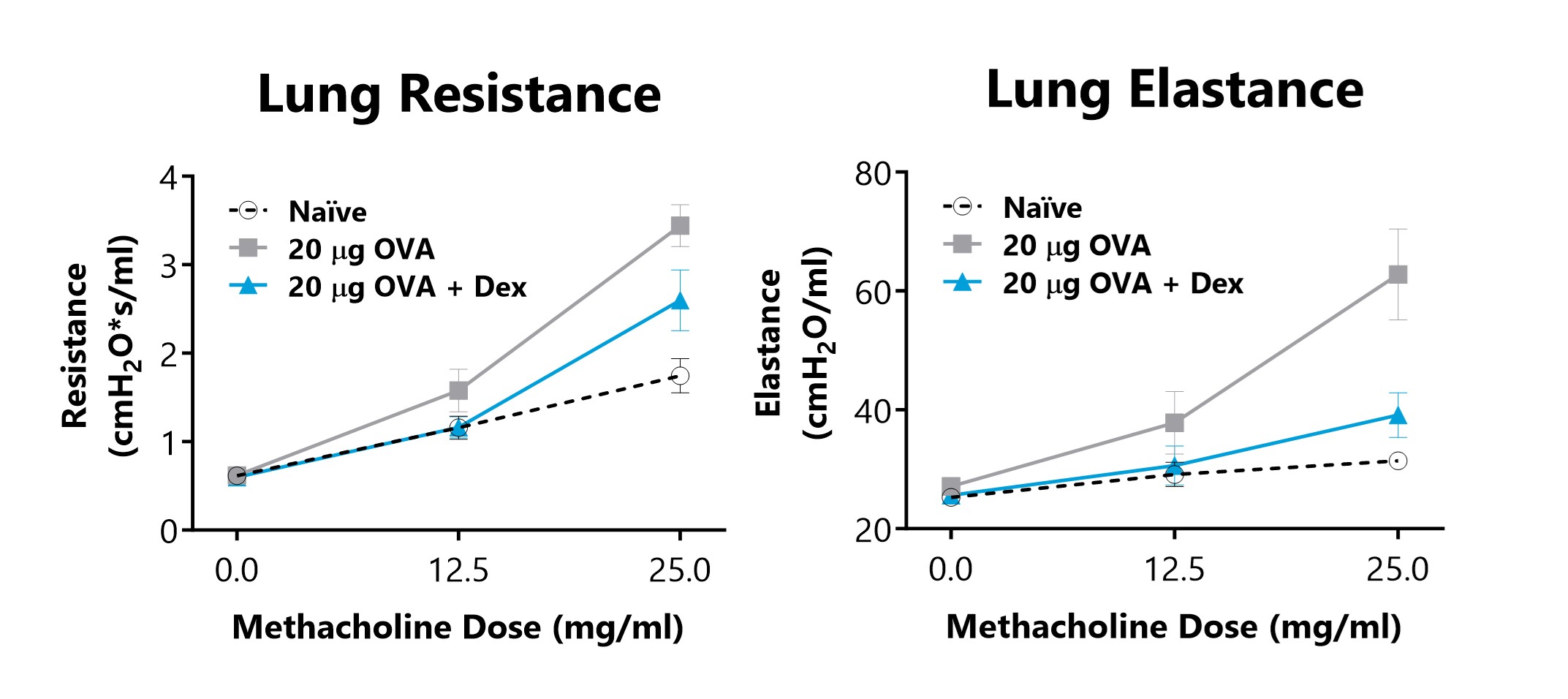
Lung Resistance and Elastance is measured on day 16 of an OVA-induced acute allergic asthma model, following exposure to increasing doses of methacholine. Animals that are sensitized and challenged with OVA displayed increased lung resistance and elastance parameters in comparison to Naïve animals. 3 mg/kg Dexamethasone treatment reduced airway hyperreactivity in diseased animals.

H&E-stained lung sections from naïve mice and mice from an OVA-induced acute allergic asthma model with and without 3 mg/kg dexamethasone treatment. The infiltration of mixed inflammatory cells observed in diseased animals is decreased in animals treated with 3 mg/kg dexamethasone.

Close

BioModels offers house dust mite (HDM) models of allergic asthma. An example of the acute HDM regimen would include sensitization on days 0 and 7 via the respiratory tract, challenge on day 14 with endpoints on day 15. Similar to the OVA model, the HDM models recapitulate many of the chronic asthma hallmarks seen in humans, however the HDM models utilize more clinically relevant allergens, as well as a more relevant route of sensitization, the respiratory tract.

BALB/c mice are sensitized with an intranasal (IN) administration of HDM on days 0 and 7. Mice are then challenged with HDM intranasally on Day 14 and endpoints are assessed on day 15. Reference treatment animals receive 3 mg/kg dexamethasone 1 hour prior to the challenge.

Total cells, eosinophils, and neutrophils recovered in broncho-alveolar lavage fluid on day 15 of an HDM-induced acute allergic asthma model. Sensitized and challenged mice demonstrate an increase in total cells, eosinophils, and neutrophils. 3 mg/kg dexamethasone treatment lowered total cells, eosinophils, and neutrophils in the BAL fluid.
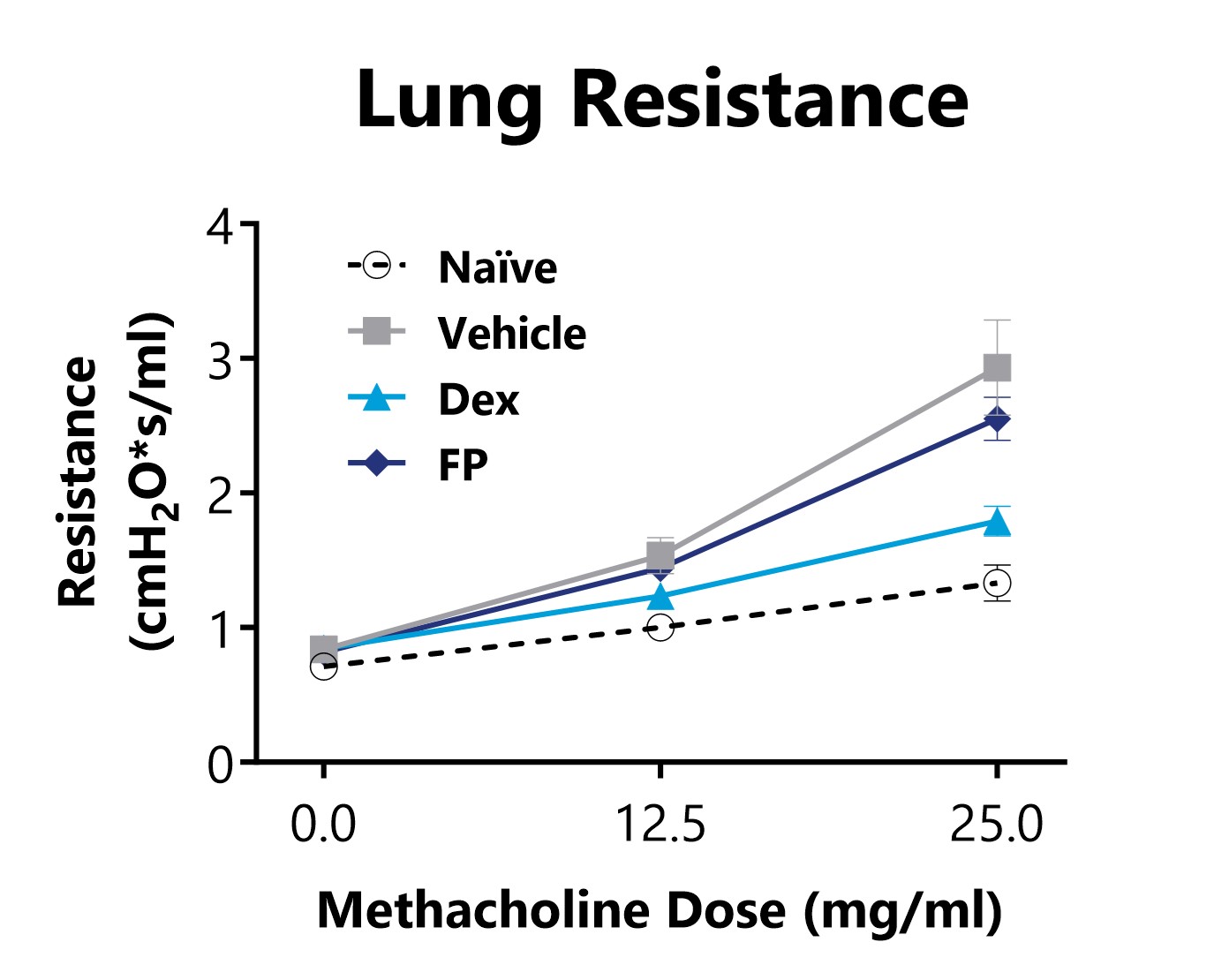
Lung Resistance is measured on day 15 of an HDM-induced acute allergic asthma model, following exposure to increasing doses of methacholine. Animals that are sensitized and challenged with HDM display increased lung resistance in comparison to Naïve animals. 3 mg/kg Dexamethasone or 1 mg/kg Fluticasone Propionate (FP) treatments reduced airway hyperreactivity in diseased animals.
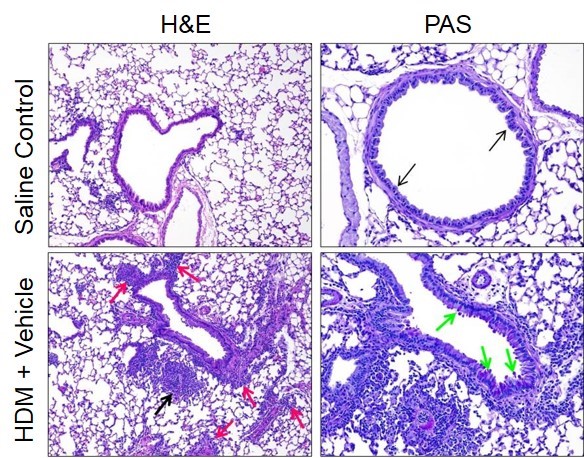
H&E- and PAS-stained lung sections from naïve mice and mice from an HDM-induced acute allergic asthma model on day 15. Infiltration of mixed inflammatory cells are observed in diseased animals in comparison to Naïve animals. Increases in multifocal inflammation within alveolar spaces (black arrow) and surrounding vessels (red arrows) are observed in lungs of diseased animals. Larger bronchioles lined with moderate numbers of PAS-positive goblet cells (green arrows) can be seen in lungs of diseased animals whereas saline control lungs had PAS-negative cells (black arrows).

Significant increases in Th2 inflammatory mediators (IL-4, IL-5, and IL-6) are observed in BAL fluid of diseased animals, though changes in IL-1β, a Th1 cytokine are not observed. Levels of IL-4, IL-5, and IL-6 in BAL fluid are significantly lower in animals treated with either 3 mg/kg Dexamethasone (Dex) or 1 mg/kg Fluticasone Propionate (FP). (*p<0.05; **p<0.01; ***p<0.001; ****p<0.0001 compared to the vehicle-control)
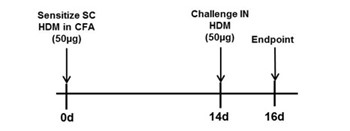
BALB/c mice are sensitized with a subcutaneous (SC) administration of 50 µg HDM in CFA on day 0. Mice are then challenged with 50 µg HDM intranasally on Day 14 and endpoints are assessed on day 16. Reference compound and test article treatments are generally administered on or around days 13-16.

Total cells, eosinophils, and neutrophils recovered in broncho-alveolar lavage fluid on day 16 of an HDM-induced severe asthma model. Sensitized and challenged mice demonstrate a significant increase in total inflammatory cells, eosinophils, and neutrophils in BAL fluid. (*p<0.05; ****p<0.0001 compared to the vehicle-control)

Images from control (saline) and severe asthma model (50µg/50µg HDM) BAL fluid. Macrophages (M), Lymphocytes (L), Neutrophils (N), and Eosinophils (E) can all be observed in the BAL fluid from mice in the severe asthma model.
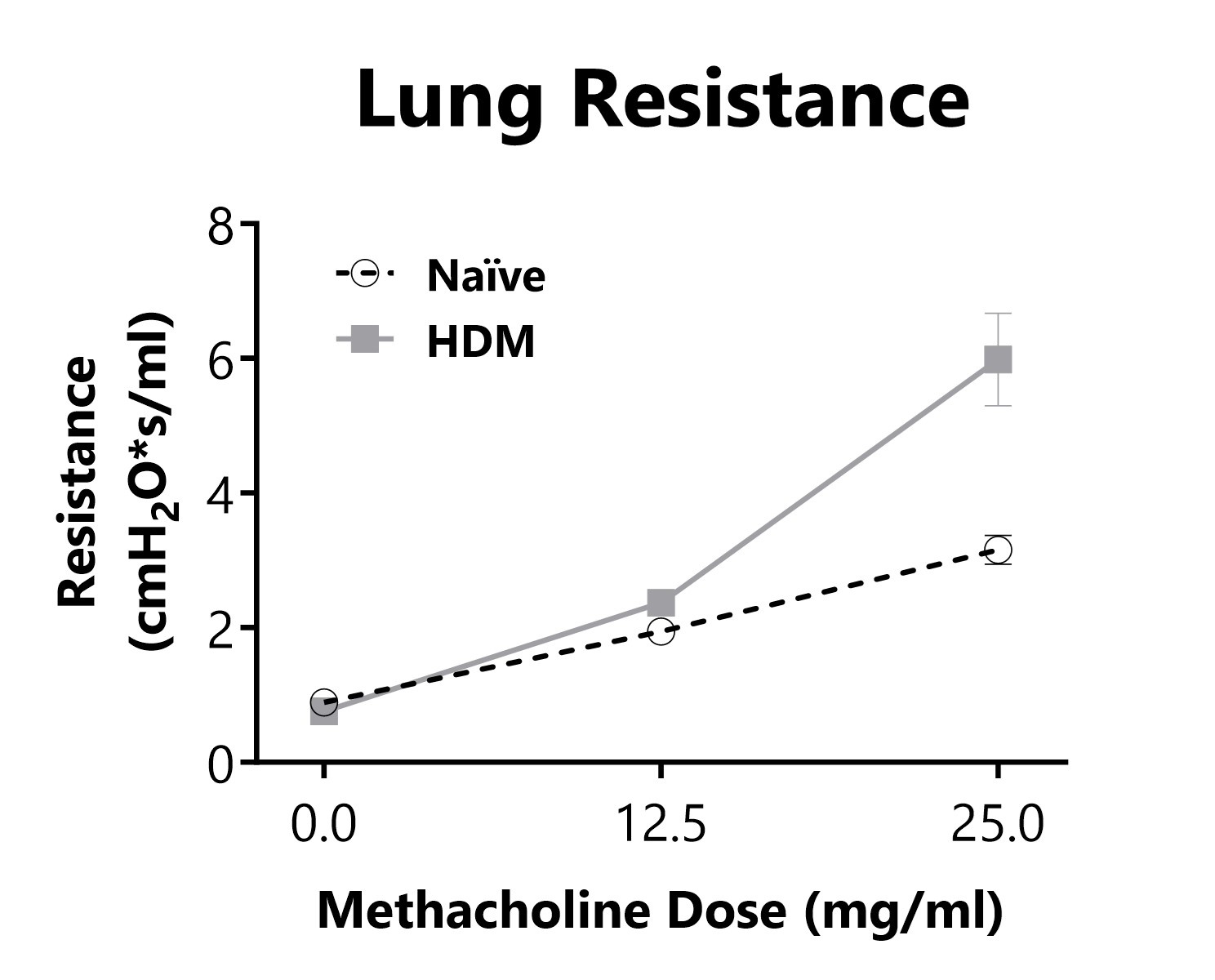
Lung Resistance is measured on day 16 of an HDM-induced severe asthma model, following exposure to increasing doses of methacholine. Animals that are sensitized and challenged with HDM display increased lung resistance in comparison to Naïve animals.

H&E- and PAS-stained lung sections from naïve mice and mice from an HDM-induced severe asthma model on day 16. An increased presence of perivascular and peribronchiolar inflammation (red arrows) is observed in diseased animals. Larger bronchioles of diseased animals are lined with moderate numbers of PAS-positive goblet cells (green arrows) whereas saline control lungs had PAS-negative cells (black arrows).

A mixed Th1/Th2 cytokine inflammatory profile in BAL fluid of diseased animals is observed in a severe asthma phenotype.

Close
Study Models

BioModels offers a mouse model of LPS-induced Acute Lung Injury (ALI). In the LPS-ALI model, mice are anesthetized and then administered LPS by the intranasal route. Animals are evaluated daily for body weight and respiratory status. Endpoints in the model are most often measured between 4-96 hours following LPS administration, with peak disease typically observed around 48 hours. Endpoints in this model include total and differential cell counts and inflammatory mediator content in the broncho-alveolar lavage fluid, detailed lung mechanics, as well as histopathology and immunohistochemistry.

BALB/c mice are administered LPS on Day 0 and BAL fluid is assessed at 24 hours.

BALB/c mice are administered LPS on Day 0 and BAL fluid is assessed at 24 hours for total cells and total neutrophils following administration of either 1 µg or 10 µg of LPS.

BALB/c mice are administered LPS on Day 0 and lung tissue is collected at 24 hours following administration of either 1 µg or 10 µg of LPS.
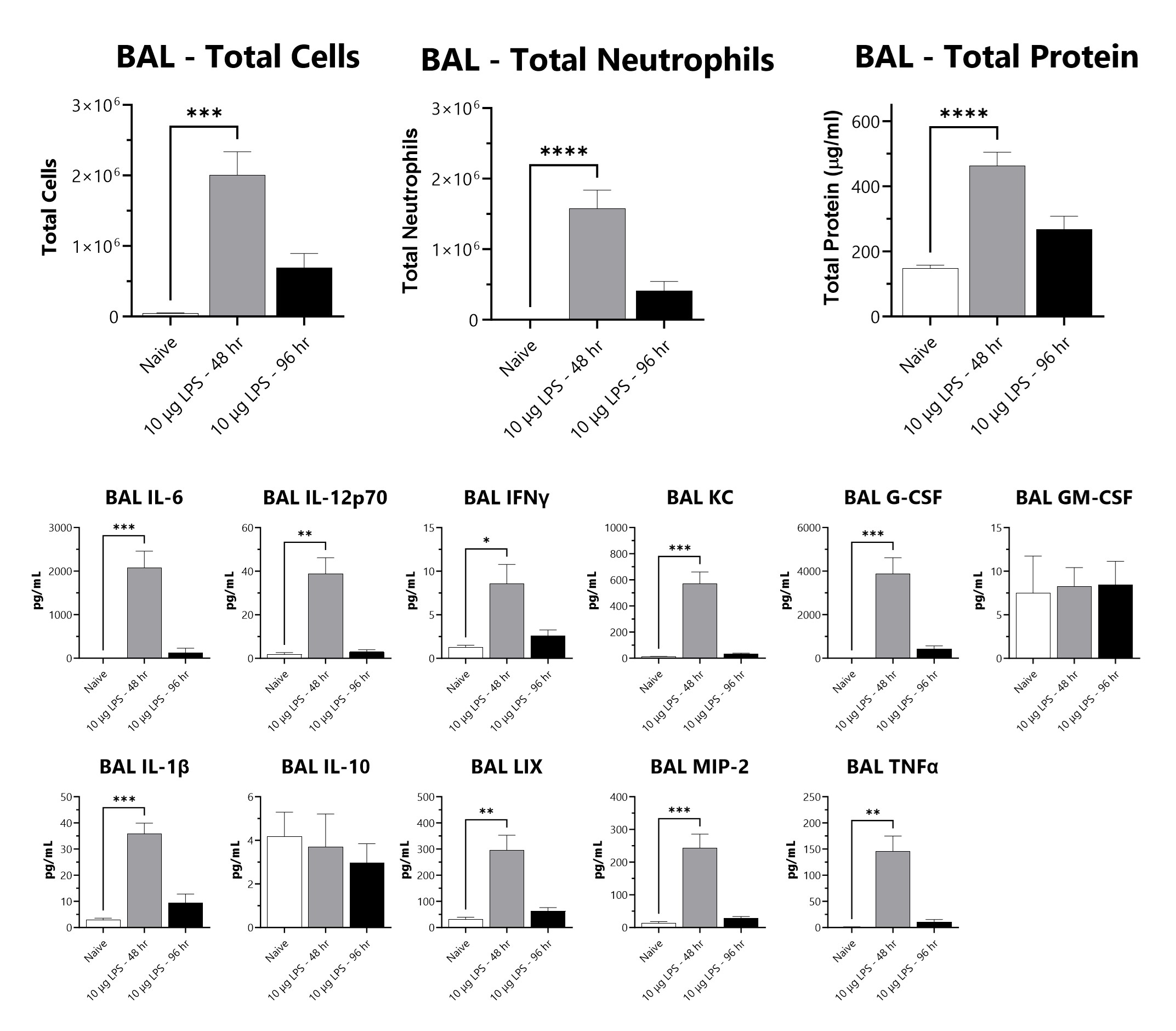
BALB/c mice are administered LPS on Day 0 and BAL fluid is assessed at 48 or 96 hours for total cells, total neutrophils, total protein, and cytokines following administration 10 µg of LPS. (*p<0.05; **p<0.01; ***p<0.001; ****p<0.0001 compared to the naïve control).
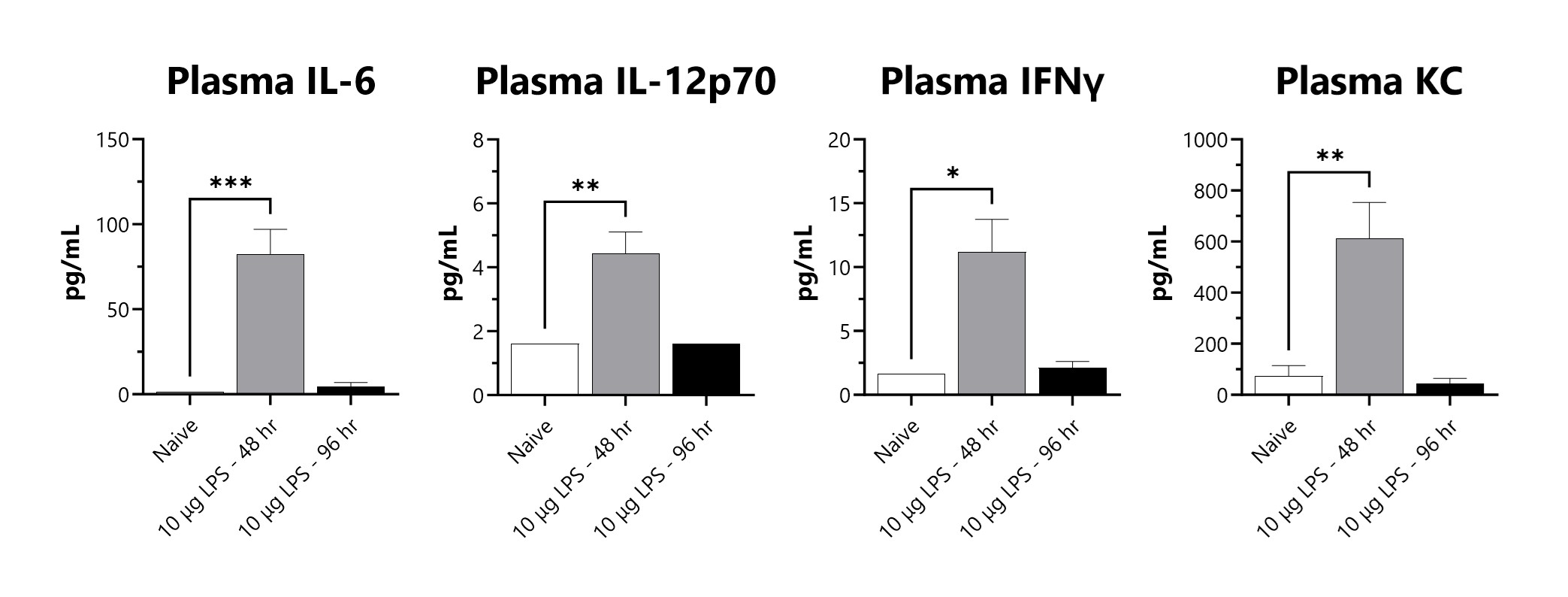
BALB/c mice are administered LPS on Day 0 and plasma is assessed at 48 or 96 hours for cytokines following administration 10 µg of LPS. (*p<0.05; **p<0.01; ***p<0.001 compared to the naïve control).
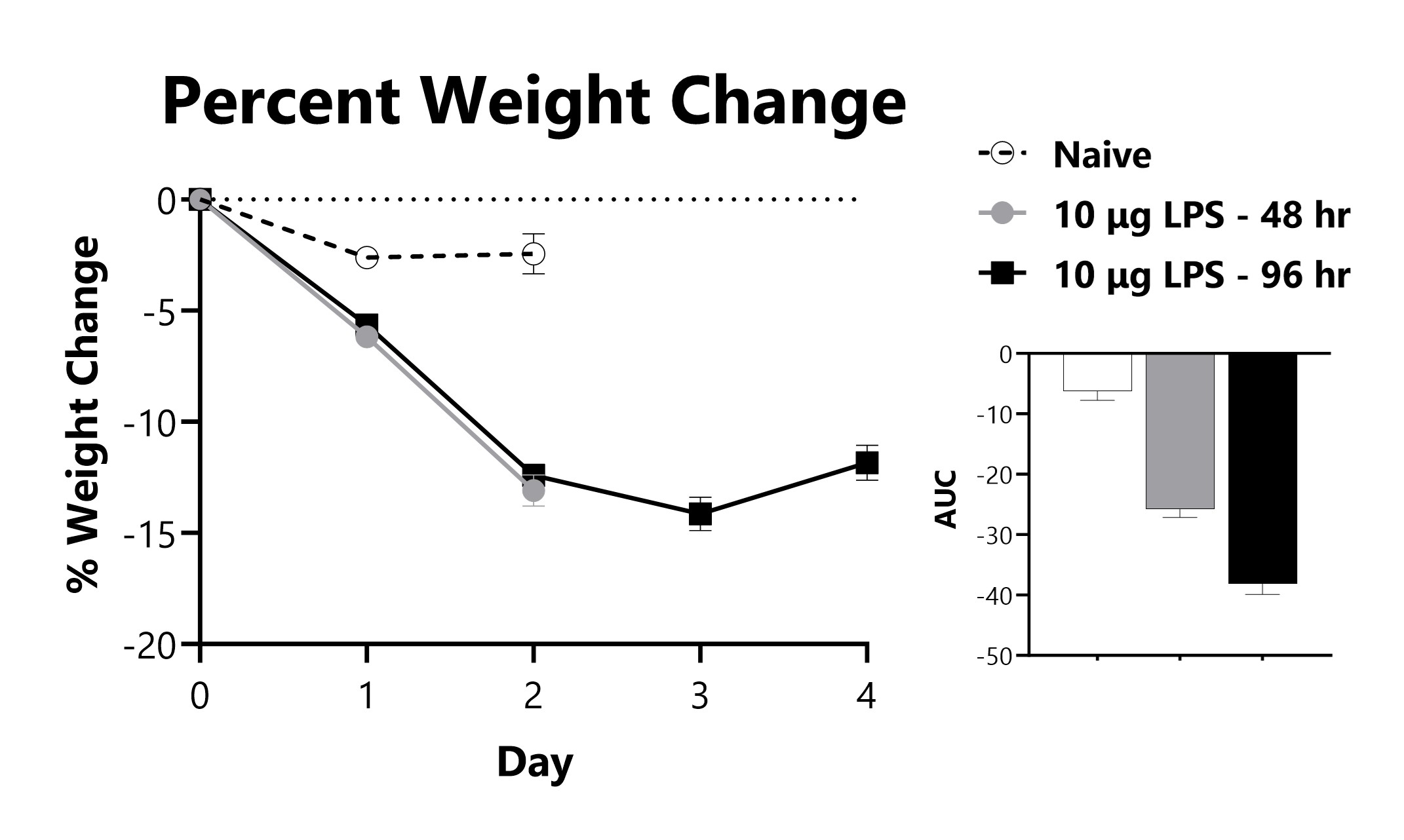
BALB/c mice are administered LPS on Day 0 and weight change is assessed. Animals are weighed daily, and body weight change as compared to Day 0 is calculated. The AUC is calculated to compare treatment arms and is shown in the inset.

BALB/c mice are administered LPS on Day 0 and lung tissue is collected at 48 hours following administration of either 10 µg of LPS or 10 µg of LPS with Dexamethasone treatment.
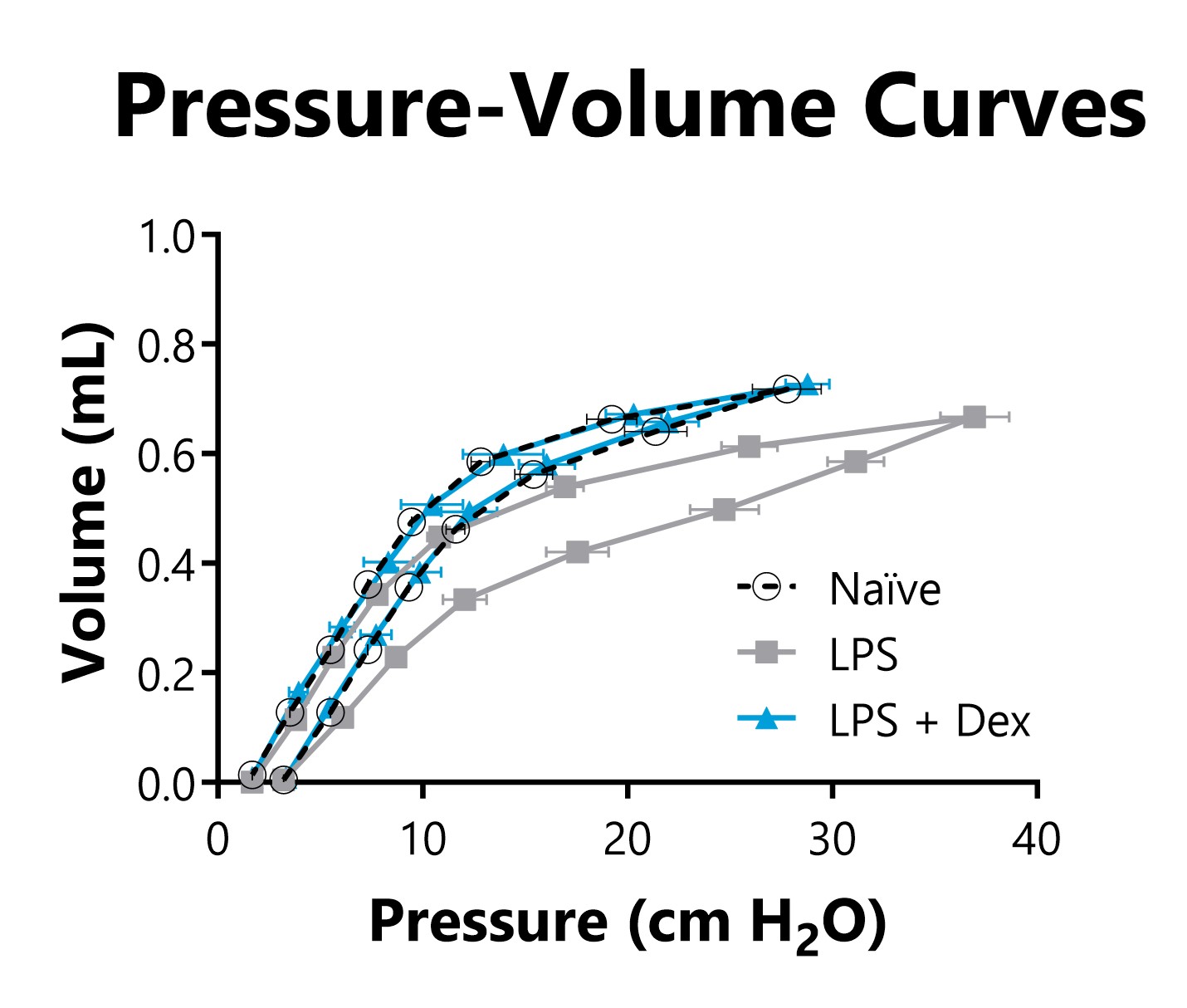
BALB/c mice are administered LPS on Day 0 and lung mechanics are assessed at 48 hours following administration of either 10 µg of LPS or 10 µg of LPS with Dexamethasone treatment.
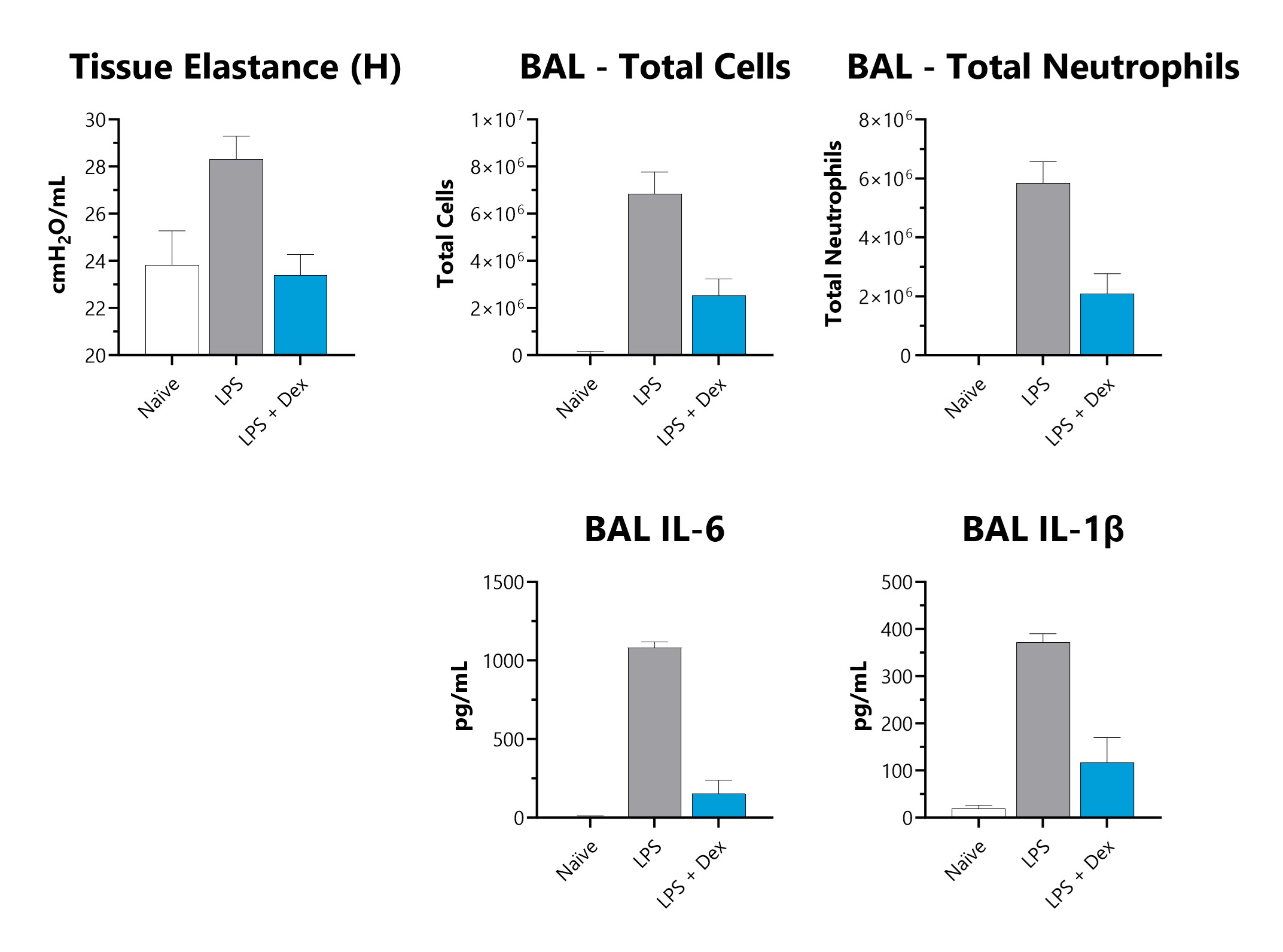
BALB/c mice are administered LPS on Day 0 and lung elastance and BAL fluid total cells, total neutrophils, and cytokines are assessed at 48 hours following administration 10 µg of LPS.

Close

BioModels offers a mouse model of hydrochloric acid (HCl)-induced Acute Lung Injury (ALI). In the HCl-ALI model, mice are anesthetized and then administered HCl by the intratracheal route. Animals are evaluated daily for body weight and respiratory status. Endpoints in the model are most often measured 24 hours following HCl administration. Endpoints in this model include total and differential cell counts and inflammatory mediator content in the broncho-alveolar lavage fluid, detailed lung mechanics, as well as histopathology and immunohistochemistry.
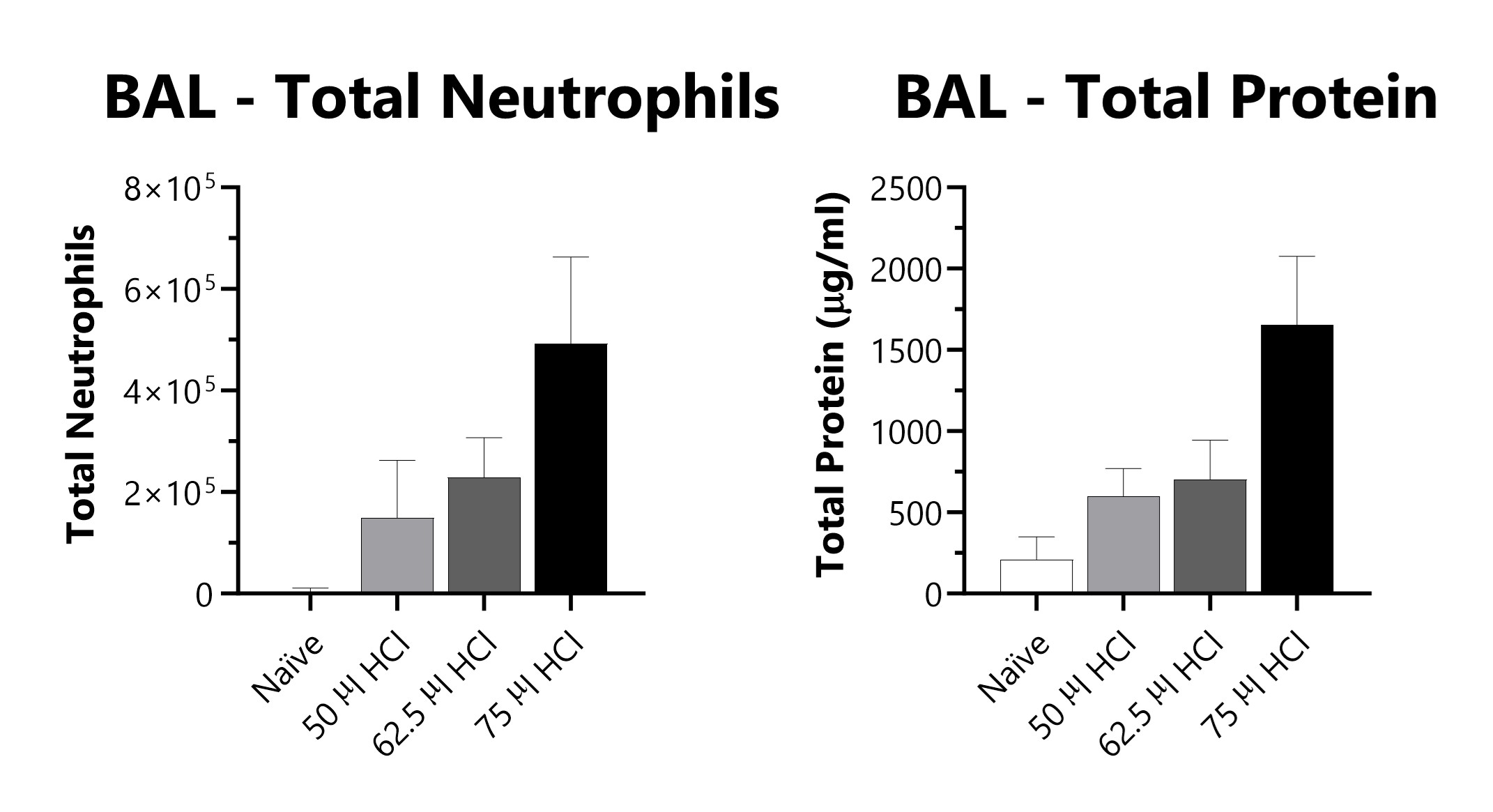
BALB/c mice are administered HCl on Day 0 and BAL fluid is assessed at 24 hours for total neutrophils and total protein content following administration of either 50 µL, 62.5 µL, or 75 µL of HCl.
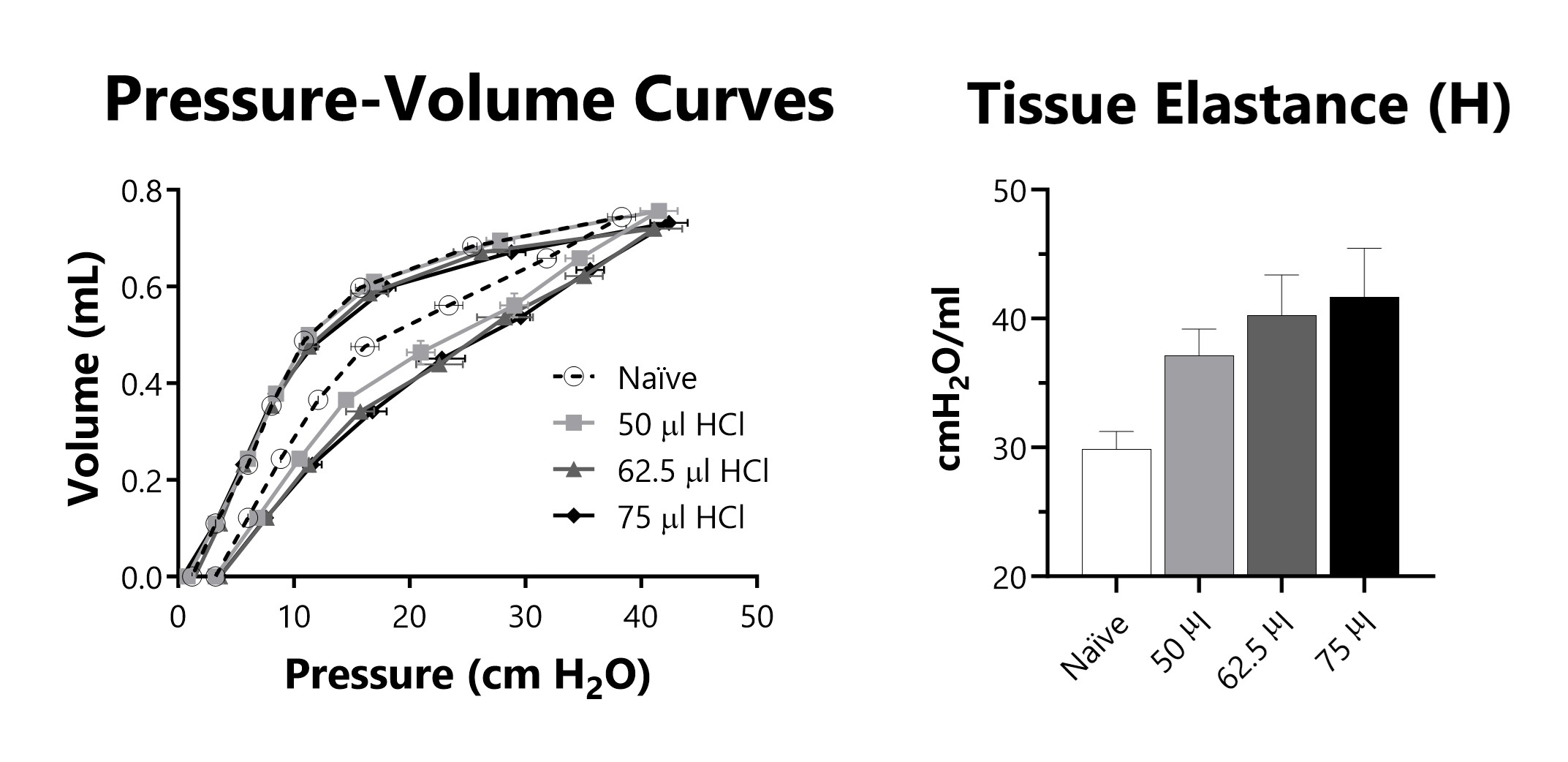
BALB/c mice are administered HCl on Day 0 and lung mechanics are assessed at 24 hours following administration of either 50 µL, 62.5 µL, or 75 µL of HCl.

Close
Your Message Was Submitted Successfully.



